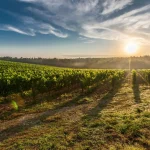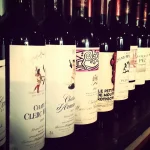A host of words – especially on this site – are devoted to the characteristics and relative merits of the wines we drink.
Sometimes, though, it is instructive to switch our attention from “what” to “why”.
Getting to know more about a favourite subject is seldom a waste of time and can lead to better informed decisions.
Today, is one such opportunity – but it does carry a cautionary note with it.
For whom do vines primarily intend the grapes they produce? [Clue: Humblingly, it is not humankind].
If that warning has not deterred you, read on with this piece by MidWeeker Paul.
In it, he returns to his former “day job” of educating the young in the classroom or science lab.
He brings his customary enthusiasm, humour and knowledge to the questions of ripeness and acidity in wine.
Here is Paul’s “Lesson”.
“At times Brian likes to set me PhD level Science problems associated with wines.
His latest one was: “Are increases in sugar as grapes ripen co-incidental to reductions in acidity, or the direct conversion of one into the other”. Discuss.
Well as I often said to my Year 9 Set 4 pupils, always go back to basics.
Vines have tendrils because they want to climb up trees to the top of the woodland canopy
That way they can eventually entice birds to eat the grapes and, subsequently, disperse viable seeds; that helps ensure reproduction.
Ripe grapes were originally dark in colour for visibility reasons.
But timing is critical
However, the plant does not want the grapes eaten before the seeds are viable.
Consequently, at first, immature grapes are hard and full of sour acid.
Through the ripening stage they become pumped up with sugar, water and the acid levels go down. Why?
“To attract the birds when the seeds are ready – but not before, Sir.”
Well done, Jones at the back. Possibly Set 3 next year!
Looked at graphically
So in the classic ripening graph, sugar levels go up in a straight incline and acid levels go down in an angled straight line and we see a classic cross shape.
The temptation then is to jump to the conclusion that the acids are directly converted to sugars.
Jones, and you Davies, how many times I have told you to avoid temptations?
Now, pupils, a short lesson on organic acids found in wine grapes:
Here are seven of them
These are tartaric, malic, citric, oxalic, acetic, succinic and lactic acid; they have antibiotic and antimicrobial properties.
The main two – 90% – are malic and tartaric acids.
Right Jones, you have your hand up, what now?
“Sir, are these acids found in wines good for you?.
Well you normally try to divert me off topic and get me talking about Welsh rugby, but that is a cracking question, well done!
So, leaving rugby alone
As you will know, certain natural substances in food connect with harmful molecules in our body, helping to protect humans from damage.
But are these acids among them?
Well, some of them promote iron consumption and, specifically, tartaric acid has positive effects on colon function while succinic acid has important implications for cardiovascular diseases.
Similarly, malic acid has a role in gastrointestinal health and citric acid has a positive effect against diabetes.
Citric and malic acids also have a protective role on the heart muscle and act on ischemic lesions (damaged areas where blood flow is blocked).
But, after that diversion.

Now enough of digressions, let’s return to the main subject.
We have established that as grapes ripen there is a rapid increase in sugar content and a decrease in acid content and concentration – especially of malic acid.
Let’s look a little more at the details
It seems that véraison (essentially when grape skins change colour) is part of a complex process leading towards that sugar accumulation in the berries.
Around that time, the vine prioritises directing sugars towards the berries – although some are still used for the plant’s ongoing energy needs.
At the same time, though, malic acid in the berries is degraded to provide a further source of energy.
Some of it, however, converts partly into the less harsh lactic acid but, again, the processes involved are complex and depend on several factors.
So, to sum up.
In short, organic acids levels are radically scaled back during ripening but some do remain.
They provide the balance and freshness in the wines that your parents may enthuse over.
But, as we have seen, the rise in grape sugar levels and drop in acidity are actually parts of a complex series of changes.
In any exam question, good marks await those who describe them as “concurrent activities” rather than “a direct conversion process”.
Now gather around and I will demonstrate how to do titration properly and then you lot can have a go.”
Editor’s Note.
Thank you, Paul, for a delightfully crafted piece shedding light on a surprisingly complex subject.
Incidentally, Grapes picture by Junior Louis Jean on Unsplash and Feature picture by SHIV SINGH on Unsplash
After today’s glimpse at a broader picture, it’s back to my day job (budget but great value wine) in Monday’s Top Tip selections.









10 responses
This is brilliant – educational *and* funny, which is a tricky balance
Thank you for your kind words,Nia-much appreciated.I love writing about wine.
It takes me to places I have been ;to places I would like to go to and places I will never visit.
Travel without the fear and cost of travelling.
But thanks must go to Brian who has taken a big risk-I think we both like a lively story and for people to be entertained.
Nice of you to share the praise, Paul, but my role is a limited one in this type of post.
Well done Paul. You even made the science here clear to someone whose education in the subject ended at what would now be the end of Year 8. (Shocking I know, moreso as it was in a selective grammar school in the 70s. What were they thinking??!)
Anyway, Brian has recommended a couple a wines in the Waitrose own-label Blueprint selection in recent months (the Waitrose Blueprint Côtes de Rhône and the Blueprint Brut Cava for example) and occasionally other Blueprint wines are discussed in MWW comments. It’s worth knowing then that ALL the bottles in this series of nearly 30 wines are currently 20% off until 6 May. The recommended Côtes de Rhône is now just £5.50 along with half a dozen others including the Romanian Pinot Noir, the Verdejo and the Vino Verde. The full collection with 20% discount can be seen on the Waitrose website
Hello Keith,
Your comments made me smile.
None of that Year 9 nonsense at my boys’ grammar school.Real education only began in secondary school.All that junior school stuff was pre- education. It was the third year and “options”.
But first- CATACLYSM -Good Lord! they let the girls in -and we became a co-ed grammar school.In my sixth form the school became comprehensive.Quite a ride.
Back to options
Arts or Sciences? I professed a liking for English Lit and History, so was put down for Science and Maths as I was told I would never be without a well paid job- half of which turned out to be true.
The only real option was Latin or Geology.I was fascinated by rocks and fossils so ticked Geology.I was called into the Headmaster’s office to be told my choice was based on incomplete knowledge and that the Head himself was taking the Latin class next year, so Latin it was.
Options?
Hi Paul,
Thanks for the entertaining article. Recently I was listening to a podcast in which the problems of fully ripe Chardonnay grapes in Burgundy, including Chablis, were discussed, e.g. the wines getting “flabby” due to lower acidity. The continued rise of Aligoté was anticipated – as the grape is unusual in that it maintains high acidity when fully ripe.
Also thanks to Keith for the heads-up on the Blueprint offer. Just today, I tasted their 2024 NZ Sauvignon Blanc, 2022 Reserve Claret and the 2024 Dry German Mosel Riesling – which I thought were all excellent, true, “entry level” examples at VG prices. Their 2024 Muscadet was decent as well, and I previously enjoyed the Gruner Veltliner. I am a fan of the Blueprint wines!
Presumably the beneficial effects of these organic acids can be felt if you eat grapes. Are they also felt if you drink wine? Do they carry through the vinification process?
Hello Jerry,
Thank you for your questions.
Yes, yes and yes.
Hello Jerry,
For some reason my original reply was filtered out.
My answers were all positive, although I would be wary of eating too many grapes, but only because of the sugar content.
Hope this helps.
Thanks! For the article and your replies. I will be wary of grapes in future, as suggested 🙂